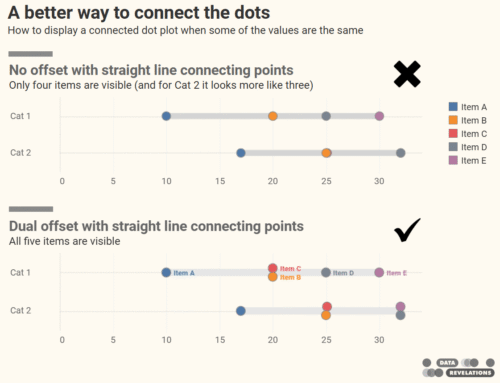Author’s note: Stephen Few is a bastion of data visualization excellence. I encourage all of my Tableau clients and students to purchase his books, read his blogs, and attend events where he is presenting.
I also submitted an entry into the competition (you can read it here).
I’ve been troubled by both the premise and results of Stephen Few’s dashboard design competition as I think it celebrates the number of disparate elements that can be crammed onto a single dashboard rather than champion the display and positioning of the elements that really need to be present (see http://www.perceptualedge.com/blog/?p=1374).
Consider this section from the instructions that accompanied the data set:
“Even though a dashboard designed for this purpose would ordinarily provide access to additional information to supplement the overview, which could be viewed by navigating to different screens or through tooltips, this won’t be addressed in this competition. Concern yourself only with the design of the initial dashboard that this teacher could use to rapidly monitor what’s going on with her students in preparation for the day’s class.”
Now let’s consider all the elements that were in the data set:
Student Name
Days Absent This Term Count
Days Tardy This Term Count
Disciplinary Referrals This Term Count
Disciplinary Referrals Last Term Count
Detentions This Term Count
Detentions Last Term Count
Latest Standardized Math Assessment Score
9th Grade Standardized Math Assessment Score
8th Grade Standardized Math Assessment Score
7th Grade Standardized Math Assessment Score
6th Grade Standardized Math Assessment Score
Assignment 1 Score
Assignment 2 Score
Assignment 3 Score
Assignment 4 Score
Assignment 5 Score
Assignments Completed Late Count
Current Course Grade
Current Course Score
Student’s Course Grade Goal
Student’s Course Score Goal
Previous Math Course Grade
Previous Math Course Score
English Language Proficiency
Special Ed Status (Y/N)
Student Absences
Student Tardies
Absences yesterday count
Tardies yesterday count
Median and bin distribution of latest standardized exam
Median and bin distribution of latest standardized exam for other class
Median and bin distribution of latest standardized exam for entire school
Median and bin distribution of latest standardized exam for entire district
So, do all these elements warrant being on the dashboard? Given that our teacher (Susan) will be looking at this dashboard every day, does she really need to see how her class compares with others on the latest standardized math test? And just how important is it to know what score Allison Perry received on her sixth grade standardized assessment test?
What’s Important
As somebody who builds (and teaches others how to build) interactive data visualizations for a living I’m always asking myself two questions:
- What is it in the data that is important; and,
- How do I convey that importance?
Maybe there’s a good reason to include years-past test scores on a daily-viewed dashboard, but my bet is that no one performed any correlation or trend analysis to connect the dots among these disparate elements.
So, given this, just what would I highlight?
In looking at both the winning and runner-up dashboards, I see that comparing a student’s current grade with his / her grade goal is featured prominently. Here’s the applicable portion from the winning entry:
Here’s how the runner up handled the same data:
Here’s my submission:
(I confess that I subscribe to the “I want people form the back of the room to be able to grok what’s going on” approach to visualization).
While I do think all of these will help Susan easily see how a student is performing against his/her goal, I think we’re still missing the “Big Story”.
The Big Story (and It’s Missing from the Winning Dashboard)
If I were Susan I would be hyperventilating because, according to the data set scenario, it’s May, the course is 80% complete and a whopping 43% of her students are below goal:
Both the winning and runner-up dashboards are missing this element, and I maintain it’s the most important story that is in the data.
So, just what should Susan do with this visualization, besides fret?
If I had different data I would try to show how actual vs. goal has been progressing over time. Maybe Susan should be thrilled because in March 65% of her students were below goal, but now only 43% are?
I can’t say, because the data available to me doesn’t track that information, but I would argue that tracking goal trends over time is a lot more valuable than displaying years-old test data.
I’m Guilty, Too
I included a visualization on the dashboard that shows how Susan’s class performed on the latest standardized exam with respect to her other class, the school, and the district.
Pretty neat, huh? This uses the staggered / divergent stacked bar chart that I so like to use for presenting LIkert scale data.
But does this really need to be here? That is, does Susan need to see this months-old data every single day as she prepares for her class?
The answer is she doesn’t and I don’t think this oh-so-clever chart belongs on the dashboard. I do, however, suggest adding data that is not in the data set as an example of something that I think would be very useful:
Great Idea, but Poor Data Set?
As I indicated in the author’s note, I’m an enthusiastic disciple of Stephen Few’s. I also like data visualization challenges / competitions and have seen my own career propelled by participating in them.
I also think the entries Few cites are beautiful and wonderfully crafted, but I can’t help but think that this particular dashboard competition needed a better data set where all the elements truly warranted being on the same dashboard. Indeed, even in his instructions, Few acknowledges that under ordinary circumstances many elements in the data set would be presented via tool tips and secondary dashboards. How can one create a truly useful dashboard that contains all of the included elements if you know that many elements just shouldn’t be there?













